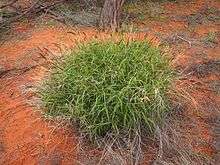Cenchrus ciliaris
| Cenchrus ciliaris | |
|---|---|
 | |
| Scientific classification | |
| Kingdom: | Plantae |
| (unranked): | Angiosperms |
| (unranked): | Monocots |
| (unranked): | Commelinids |
| Order: | Poales |
| Family: | Poaceae |
| Subfamily: | Panicoideae |
| Genus: | Cenchrus |
| Species: | C. ciliaris |
| Binomial name | |
| Cenchrus ciliaris | |
| Synonyms | |
| |
Cenchrus ciliaris (buffel-grass[1] or African foxtail grass; syn. Pennisetum ciliare (L.) Link) is a species of grass native to most of Africa, southern Asia (east to India), southern Iran, and the extreme south of Europe (Sicily).[2] Other names by which this grass is known include dhaman grass, anjan grass and koluk katai.[3]
Description
African foxtail grass is a perennial grass growing to 20 to 120 cm (10 to 50 in) tall. The leaves are linear, 3 to 25 cm (1 to 10 in) long and 4 to 10 mm (0.16 to 0.39 in) wide. The flowers are produced in a panicle 2 to 14 cm (0.8 to 5.5 in) long and 1 to 2.6 cm (0.4 to 1.0 in) wide.[4]
Distribution
African foxtail grass is native to tropical Africa, the Mediterranean region and the hotter and drier parts of Asia. It is a deep-rooted grass, tolerates drought, and will grow at altitudes of up to 2,000 m (6,600 ft). It is considered a good forage grass in Africa. It prefers light soils with a high phosphorus content. Cenchrus ciliaris has become naturalised and often an invasive species in Australia, the southwestern United States, Hawaii, Mexico, Central America, South America, and Macaronesia.[2] In the Sonoran Desert it was introduced for erosion control. In the Mexican part of the Sonoran Desert, it is still being planted and irrigated for livestock grazing. It is also sown in Queensland, Australia for grazing, hay and silage.[3]
As an invasive species
It was introduced in the 1930s into Arizona, United States, to provide grazing. The introduction was largely unsuccessful but the grass began to appear as a weed beside highways and in cleared fields or over-grazed land. It spreads very quickly and will often kill local native plants such as palo verdes by taking away nearby water. This plant has a very low ignition threshold and can burn even during the peak growing season. Its flammability (injurious to neighbors) and quick regrowth allow it to compete successfully against almost all vegetation in the Sonoran Desert region.[5]
In Queensland, Australia, the grass has also been attributed to causing a decline in the native grass species fed on by the critically endangered northern hairy-nosed wombat, and cited as a factor in the wombats' decline.[6] In South Australia, it is a declared plant under the Natural Resources Management Act and weed management activities are guided by the South Australia Buffel Grass Strategic Plan (2012–17).[7]
References
- ↑ "BSBI List 2007". Botanical Society of Britain and Ireland. Archived from the original (xls) on 2015-01-25. Retrieved 2014-10-17.
- 1 2 "Cenchrus ciliaris". Germplasm Resources Information Network (GRIN). Agricultural Research Service (ARS), United States Department of Agriculture (USDA). Retrieved 22 December 2017.
- 1 2 "Cenchrus ciliaris L." Grassland species: Profiles. FAO. Retrieved 22 November 2016.
- ↑ Clayton, W.D.; Vorontsova, M.S.; Harman, K.T.; Williamson, H. "Cenchrus ciliaris". GrassBase - The Online World Grass Flora. Royal Botanic Gardens, Kew.
- ↑ Arizona-Sonora Desert Museum: Buffelgrass.
- ↑ "Buffel grass (Cenchrus ciliaris) as an invader and threat to biodiversity in arid environments: A review". Journal of Arid Environments. 78: 1–12. 2012-03-01. doi:10.1016/j.jaridenv.2011.11.005. ISSN 0140-1963.
- ↑ "Buffel Grass". Primary Industries and Regions South Australia. Primary Industries and Regions South Australia. 13 February 2017. Retrieved 21 June 2017.